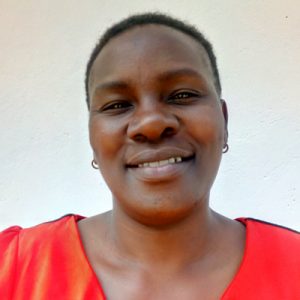St. Stephens ACK Eshiakhulo Secondary School began in 2014 with just two classrooms, originally located within the primary school. Today, the school continues to grow, currently serving 216 students and 17 teachers and staff. The school is next to two churches, including the Anglican Church of Kenya (ACK), the school's spiritual sponsor. At the time of our last visit, there was a lot of activity in the community surrounding the school as people prepared for the upcoming planting season on their farms.
Despite two different water points, the school still faces severe water shortages. The first source is a tiny plastic rain tank - just 5,000 liters in volume - that runs dry almost immediately after the rains. For most of the year, the tank sits empty. Then, there is a hand-dug well with a hand-pump. But the well is very shallow, meaning it does not tap into the water table below ground. This means that during the dry seasons, or even when students use it too much in one day, the well runs dry.
Without reliable water on campus, the students turn to two off-campus options for water: carrying it from home, or fetching it from a protected spring in the village. Both require tedious trips off campus that waste a lot of precious learning time. Students have to break to fetch water several times a day, depleting them of their energy and focus when they finally return to class and, consequently, dragging down their academic performance.
"When we fetch water at the spring, the community is not happy with us using the spring," said student Sauba. Conflicts between community members and the students are common due to the added wait time and crowding students' presence creates. Sometimes, students find themselves at odds with their own parents who also need to fetch water. Most times, the students are forced to wait until all of the adults have fetched water first before they are allowed to do so.
When students bring water from home, teachers cannot monitor where students fetch water. That means that some students choose puddles and streams along the road to school simply for their convenience, hoping it will help them get to school on time. Even at the spring, students' dirty jerrycans and mishandling of the water on the walk can contaminate the spring water. Because water is combined for use at school, even one dirty source means everyone is at risk of water-related illnesses. Students and teachers alike most commonly report cases of stomachaches, dysentery, and typhoid after drinking water at school.
"I am always insecure about drinking this water because I contracted dysentery and typhoid," said teacher Barthelemew Omutere Lusaa.
What We Can Do:
Rain Tank
A 75,000-liter rainwater catchment tank will help alleviate the water crisis at this school. The school will help collect the needed construction materials such as sand, bricks, rocks, and water for mixing cement. We will complement their materials by providing an expert team of artisans, tools, hardware, and the guttering system. Once finished, this tank will begin catching rainfall that will be used by the school’s students and staff for drinking, handwashing, cooking, cleaning, and much more.
We and the school strongly believe that all of these components will work together to improve standards at this school, which will help lead to better student academic performance and will help to unlock the potential for these students to live better, healthier lives.
Handwashing Stations
There is currently nowhere for students to wash their hands after using the latrines or before eating lunch, let alone the water to do so.
The student health club will oversee the 2 new handwashing stations we will provide, and make sure they are kept clean and in working condition. The club leaders will fill the handwashing stations with water daily and make sure they are always supplied with a cleaning agent such as soap or ash.
VIP Latrines
We will construct 2 triple-door latrine blocks using local materials that the school will help gather. 3 doors will serve the girls while the other 3 will serve the boys. All of these new latrines will have cement floors that are designed to be easy to use and to clean. And with a rain tank right on school property, there should be enough water to keep them clean.
Training on Health, Hygiene, COVID-19, and More
We will hold a 1-day intensive training session with students, teachers, and parents. This training will cover a wide range of topics including COVID-19 symptoms, transmission routes, and prevention; personal and environmental hygiene; and the operation and maintenance of the rain tank, latrines, and handwashing stations. There will be a special emphasis on handwashing.
Our team of facilitators will use a variety of methods to train, including participatory hygiene and sanitation transformation, and asset-based community development. We will initiate a student health club, which will prepare students to lead other pupils into healthy habits at school and at home. We will also lead lectures, group discussions, and provide illustrative handouts to teach health topics and ways to promote good hygiene practices within the school including handwashing and water treatment. We will then conduct a series of follow-up trainings before transitioning to our regularly scheduled support visits throughout the year.

 Rainwater Catchment
Rainwater Catchment
 Rehabilitation Project
Rehabilitation Project







































